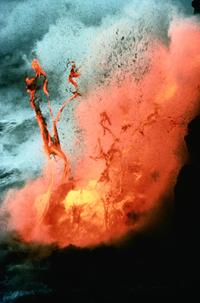Volcanoes, planes and dinosaurs
Thus, almost twenty years ago, in 1991, the Pinatubo volcano erupted (Philippines). XX. It was one of the great eruptions of the 20th century. The volcano projected 10 cubic kilometers of material and the ashes that expanded in the atmosphere had a global effect: they prevented the solar rays from reaching the Earth's surface and the temperature of the Earth decreased between 0.4 and 0.5 °C in that year.

However, the most violent eruption of historians is that of Tambora (Indonesia). It happened in 1815 and, according to geologists, was probably the biggest eruption of the last 10,000 years. It is estimated that it released more than 50 cubic kilometers of material, the height of the mountain was reduced by about 1,300 meters, and that researchers who released the cloud of sulfur dioxide and ash spread all over the world (traces of this volcanic ash have been found in the ice of Greenland and Antarctica).
Thus, the temperature decreased between 0.4 and 0.7 °C and 1816 was a "year without summer" in Europe and North America. The scientists of the time attributed the hardening of the climate to sunspots or ice cream that were released in the North Pole. The blame was also on the lightning rods, whose proliferation caused a change in the dynamics of electric currents in the atmosphere that made summer so cold. They did not suspect that a volcano that exploded at the other end of the world could influence the climate.
Influence of volcanoes on evolution
Now scientists know that large eruptions have a direct influence on the climate. And since evolution is directly related to climate, volcanoes also influence the disappearance of some species and the emergence of new ones.
For example, about 70,000 years ago the Toba volcano exploded in Indonesia. It is a supereruption that caused a climate change that greatly reduced the human population. It declined so much that some scientists believe it reduced genetic variability. This is what geneticists call the "bottleneck" effect and has a total influence on the evolution of the human species. In fact, according to this hypothesis, the current population is subsequent to the one that survived from the volcano eruption, and it is estimated that only 5,000 to 10,000 individuals survived.
Going back a lot in time, about 65 million years ago, dinosaurs disappeared, loss that some associate with volcanoes. Although the most accepted theory to explain the disappearance of dinosaurs is the theory of shock, not all researchers agree on it. For example, paleontologist Gertatu Keller of Princeton University believes that the eruptions of Deccan (India) caused his disappearance.
Recently Brown University paleontologists have suggested the opposite, that is, volcanic eruptions helped dinosaurs prevail. In fact, 200 million years ago Pangea was distributing the supercontinent and the eruptions were uninterrupted. These paleontologists have come to the conclusion that, as a result of the eruptions, the dominant species at that time disappeared, a crocodile animal called crurotarsan. Dinosaurs took advantage of this to become owners of the planet.
Volcanologists warn that more eruptions can occur in Iceland, as a cycle of high activity appears to have begun. However, it is not necessary to think that the situation of billions of years will be renewed: The Earth is aging and is not as alive and aggressive as then.
Published in Gara
Buletina
Bidali zure helbide elektronikoa eta jaso asteroko buletina zure sarrera-ontzian











